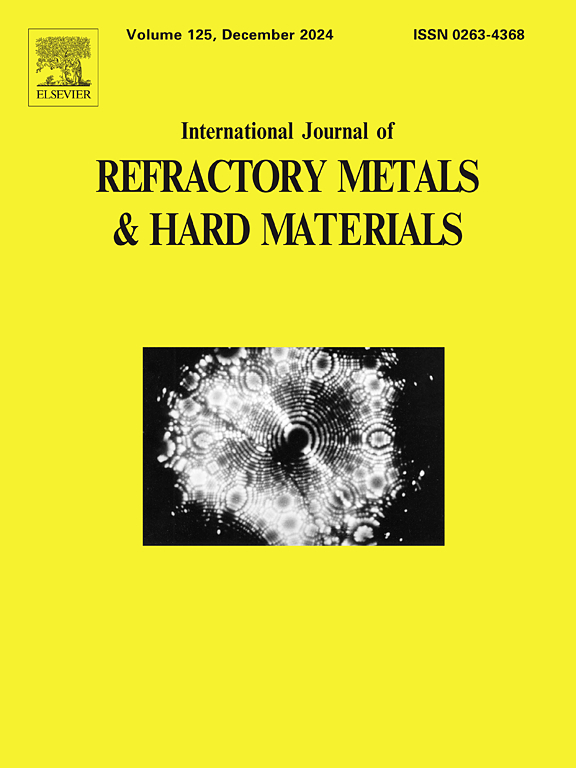Effects of femtosecond laser surface modified WC and NbC based inserts during the face-milling of automotive Grey Cast Iron (a-GCI)
IF 4.2
2区 材料科学
Q2 MATERIALS SCIENCE, MULTIDISCIPLINARY
International Journal of Refractory Metals & Hard Materials
Pub Date : 2025-01-20
DOI:10.1016/j.ijrmhm.2025.107068
引用次数: 0
Abstract
Rapid pulsed electric current sintering (PECS), TiC, TiC7N3 and Mo additions, and femtosecond (fs) laser surface modification (LSM) were used to improve the machining of automotive grey cast iron (a-GCI) using WC and NbC based cemented carbides cutting inserts. Additions of Mo and TiC as well as the use of PECS refined the grain sizes of NbC-12Ni based cermet from ∼4.6 μm to ∼1 μm, increasing the hardness (by ∼3 GPa) and wear resistance. Shark skin (S-LSM) and pyramidal (P-LSM) patterns were introduced to improve the wear and mechanical impact resistance of the cutting inserts. Face milling of a-GCI was performed at 200 m/min cutting speed (Vc), 1.0 mm depth of cut (ap), and 0.1 mm/tooth feed rate (f). The insert cutting-edge wear and damage were evaluated after every pass using optical microscopy and high angular annular dark field scanning transmission electron microscopy (HAADF-STEM). The machining performance of the cutting inserts was assessed by cutting forces, wear, and cutting insert tool life. The PECS produced NbC-10TiC-12[Ni/Mo] (wt%) P-LSM cutting insert had the lowest flank wear rate (FWR) (1.44 μm/min) after 20 min of machining. In addition, both the S-LSM and P-LSM patterns improved the cutting insert tool life of PECS produced NbC-12[Ni/Mo] (wt%) blank (B) cutting insert by ∼300 % and ∼ 900 %. Resulting in FWRs reductions of the respective insert from 21.04 μm/min after 2 min of machining to 5.97 μm/min and 1.94 μm/min after 8 min and 20 min. In general, LSM improved the NbC based cutting inserts' tool life and reduced the FWRs.
求助全文
约1分钟内获得全文
求助全文
来源期刊
CiteScore
7.00
自引率
13.90%
发文量
236
审稿时长
35 days
期刊介绍:
The International Journal of Refractory Metals and Hard Materials (IJRMHM) publishes original research articles concerned with all aspects of refractory metals and hard materials. Refractory metals are defined as metals with melting points higher than 1800 °C. These are tungsten, molybdenum, chromium, tantalum, niobium, hafnium, and rhenium, as well as many compounds and alloys based thereupon. Hard materials that are included in the scope of this journal are defined as materials with hardness values higher than 1000 kg/mm2, primarily intended for applications as manufacturing tools or wear resistant components in mechanical systems. Thus they encompass carbides, nitrides and borides of metals, and related compounds. A special focus of this journal is put on the family of hardmetals, which is also known as cemented tungsten carbide, and cermets which are based on titanium carbide and carbonitrides with or without a metal binder. Ceramics and superhard materials including diamond and cubic boron nitride may also be accepted provided the subject material is presented as hard materials as defined above.

 求助内容:
求助内容: 应助结果提醒方式:
应助结果提醒方式:


